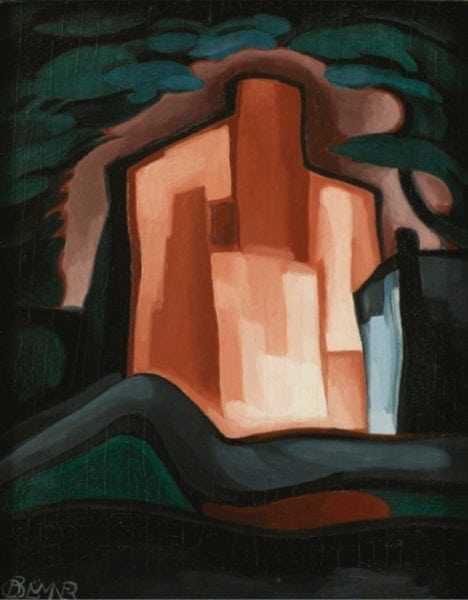A House in the Night, 1929
Oscar BluemnerOil on panel
10 × 8 inches
Signed with the artist’s monogrammed signature “O Bluemner” lower left.
Also signed “OscarBluemner”, dated 1929,
titled “A House in theNight”
and numbered “11” twice on the reverse and on the frame
Provenance
Mr. and Mrs. John F. Goldsmith, 1929 until at least 1990
Private collection, New York
In 1929, Oscar Bluemner painted a remarkable set of small brilliant panels depicting his typical subjects of houses and trees in an abstract landscape. These twenty oil-paintings were exhibited that November at the Whitney Studio Galleries; A House in the Night was number 11.[i] The Whitney pictures are among the most accomplished and original of his oeuvre. They exhibit the smooth, shellac-like finish he developed in his later watercolors through a casein varnish. In these oils, he covered each paint layer with poppy or linseed oil and then meticulously waited several days to allow for ample drying. His final varnish was a mixture he made of drying oils and resins, resulting in a hard, saturated, luminous, glass-like surface. Always concerned with permanence and durability, Bluemner even painted the back of A House in the Night to prevent the panel from warping due to changes in the humidity.
The 1929 oils are not only superb for their technical perfection, they also display a softening of contour and color that make them extremely lyrical. Trained as an architect, Bluemner’s early work displays a severe geometry in the forms. Yet the houses in A House in the Night, created through flat areas of modulated color laid next to each other, shift and bend. Surrounding the houses, biomorphic elements suggest a set of innocuous green clouds or plant forms, while an abstracted aureole evokes a sunset. Below the house, triangular shapes hint at a figure’s bent knee and stretched torso, while also bringing to mind mountains.[ii] For Bluemner, color was, above all, the vehicle for conveying emotions. A House in the Night, is no longer dominated by Bluemner’s signature intense red, but the full-range in Bluemner’s palette and rich color contrasts, signify introspection and balance. Bluemner was a careful planner, working through several phases of sketching, drawing, and experimenting with colors before he commenced painting. Each step honed his choice of color, tone, and shape to emphasize the psychological and symbolic quality. While the American market of the 1920s was not always sure what to make of his paintings, the beauty, abstraction and spirituality of Bluemner’s oeuvre speak eloquently to the contemporary audience.
[i] Fifteen out of twenty works sold during the run of the show. This painting was bought by Mr. and Mrs. John F. Goldsmith.
[ii] Bluemner called his paintings ‘psychological landscapes’ and explained that forms in his work could be read as either male or female. Houses were considered ‘masculine while trees were ‘feminine’. In this case, the mountains/recumbent figure, suggest a female counterpart to the structure above.
Note: Bluemner painted the back of panel in order to diminish warping, using his signature color — red. He also wrote a long inscription. Similar inscriptions can be found on other works, such as Moon – Night Mood (1929).
Oscar Bluemner 102 Plain Pl
S.Braintree Mass
Oil brush painting 8 x 10
1929 Catalogue #11 “A house in the night”
can be varnished 1931 with Mastix
Do not hang in sunlight
Dust only with Dry chamois
should be glazed with airspace
#17
ra 20 red
Exhibited
- New York, Whitney Studio Galleries, Exhibition of Twenty New Oil Paintings on Panels by Oscar Bluemner, Nov. 4-Nov. 23, 1929, no. 11.
- Ithaca, NY, Herbert F. Johnson Museum of Art, Cornell University, Ithaca, New York, Cornell Collects: A Celebration of American Art from the Collections of Alumni and Friends, August 21– November 4, 1990, no. 67.
Literature
- Exhibition of Twenty New Oil Paintings on Panels by Oscar Bluemner, exh. cat., Whitney Studio Galleries, New York, (1929), no. 11.
- Cornell Collects: A Celebration of American Art from the Collections of Alumni and Friends, exh. cat,, Herbert F. Johnson Museum of Art, Cornell University, Ithaca, New York, (1990), pp. 64, 168, no. 67.

